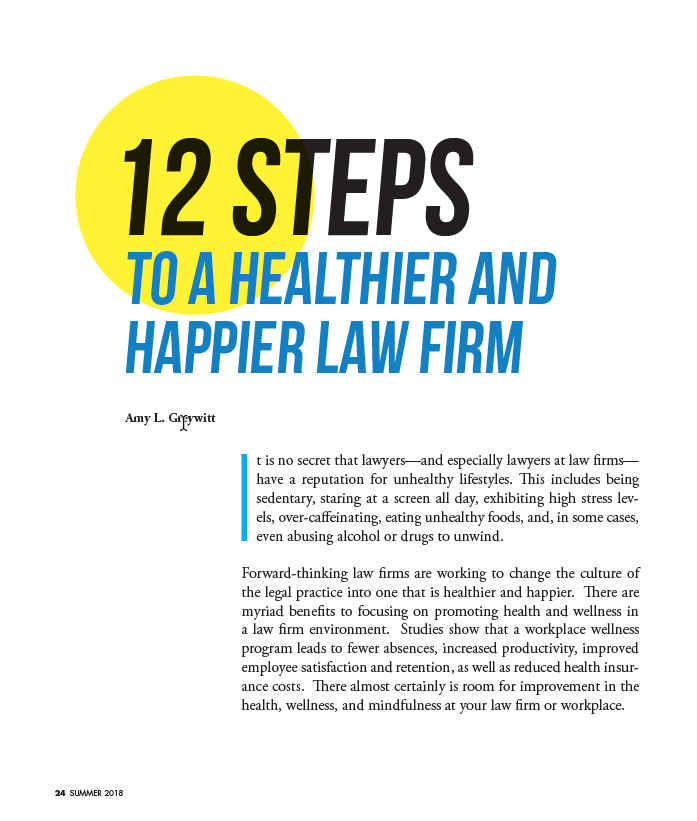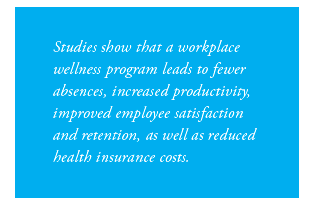
It is no secret that lawyers—and especially lawyers at law firms—have a reputation for unhealthy lifestyles. This includes being sedentary, staring at a screen all day, exhibiting high stress levels, over-caffeinating, eating unhealthy foods, and, in some cases, even abusing alcohol or drugs to unwind.
Forward-thinking law firms are working to change the culture of the legal practice into one that is healthier and happier. There are myriad benefits to focusing on promoting health and wellness in a law firm environment. Studies show that a workplace wellness program leads to fewer absences, increased productivity, improved employee satisfaction and retention, as well as reduced health insurance costs. There almost certainly is room for improvement in the health, wellness, and mindfulness at your law firm or workplace.
Here is a list of 12 ideas
that you — yes, you — can initiate in your workplace.
1. If your law firm does not have a health and wellness committee, start one. Employees need to have an outlet to express concerns and ideas related to improving their health and wellness, and this is where everything starts. Ask your firm’s management committee for a budget. Take a survey of the changes that you and your employees would like to see in your firm’s culture and benefits. You may have to start small, but over time, change is possible.
 2. Take a look at the nutrition available to employees during the workday. Food is what fuels the body and mind to do its best work. Make sure quality fuel is available to yourself and your colleagues.
2. Take a look at the nutrition available to employees during the workday. Food is what fuels the body and mind to do its best work. Make sure quality fuel is available to yourself and your colleagues.
If your law firm provides food, snacks, or beverages, take a look at the options and see what can be made healthier. For example, swap out the cookies, chips, or candy in the kitchen cabinet for nuts, protein bars, and, if possible, fresh fruit or yogurt in the fridge. If your firm offers donuts or pastries in the morning, see if the options can be varied to include fruit, oatmeal, fresh squeezed juices, or smoothies.
3. Bring in beneficial beverages. If your law firm provides beverages or has vending machines, swap out some or all of the soda options for sparkling water and unsweetened iced tea. Ensure that non-dairy options such as almond or soy milk are available for employees with lactose sensitivity, or for those who simply prefer to eat a plant-based diet.
4. Evaluate the ergonomic options to employees. Find out if your firm can subsidize standing desks, or, at the very least, provide information to employees to streamline the process to obtain a standing desk. The ability to switch between sitting and standing throughout the day improves circulation and posture and thwarts back pain often associated with being sedentary and slumping over a keyboard. Line up a specialist on an annual or more frequent basis to conduct ergonomic assessments with employees to ensure proper positioning of the keyboard and mouse, desk height, and chair settings to avoid carpal tunnel syndrome, back pain, and a host of other problems stemming from poor ergonomics.
5. Share a treadmill desk. Although law firms may not be on board to pay for treadmill desks for employees, it is a much easier sell to convince a firm to implement one or two shared treadmill desks in a visitor office or cubicle where attorneys or staff can go to dock their computers and work while walking. For logistical purposes, it helps to include the treadmill desk in the firm’s room reservation system so that employees can reserve it in advance-for instance, to walk during long conference calls or tedious document reviews.
6. Implement a firm-wide walking challenge. One of the best ways to get people moving and active is to create a friendly competition. There are several vendors that provide platforms for employees within an organization to track steps, form teams, and compete with one another to log the most steps. Most of these platforms now automatically sync with all kinds of step-tracking devices and watches, including apps that employees can download for free on a smartphone, so the cost to the firm need not necessarily include purchasing pedometers. Run the program for six to eight weeks and give out incentives for those logging the highest number of steps, or demonstrating the most improvement.
7. Start a weekly or monthly yoga program. Many firms are now offering yoga classes during the workday. Several companies, such as Office Yoga, specialize in workplace yoga classes. Book a trial class, reserve a conference room, clear the tables, and gauge interest. If people like it (which they most likely will), lobby for the firm to fund the program. Yoga increases strength and flexibility, reduces stress, and is an awesome way to unwind after a stressful day.
 8. Enjoy exercise with colleagues. Rather than hitting happy hour to consume alcohol and unhealthy food, gather your colleagues for a run on the Embarcadero, or join a class at a group fitness studio.
8. Enjoy exercise with colleagues. Rather than hitting happy hour to consume alcohol and unhealthy food, gather your colleagues for a run on the Embarcadero, or join a class at a group fitness studio.
9. Register a firm team for a walking or running event for a good cause. Pick something accessible with various options for distance and intensity so that your colleagues newer to fitness feel welcome to participate. The added benefit of choosing an event for a cause that you or one of your colleagues is passionate about will help incentivize participation.
10. Focus on mindfulness with a meditation program. Starting a monthly meditation program is a great first step to improving mindfulness in the workplace. Bring folks in your firm together once a month for a short meditation session. Taking time to quiet the mind and focus on one’s breathing over time helps attorneys and staff to respond to stressful workplace situations with equanimity. You can simply gather and follow guided meditation videos available for free online, or you can check out Unplug Meditation or YogaGlo for a very affordable monthly subscription to guided meditation videos.
11. Ask for an employee budget for fitness activities or negotiate subsidized membership options with local gyms for members of your organization. Even if it is a small amount of savings, humans are hardwired to take and use money given to them for a particular purpose, rather than lose it. The idea of getting a small monthly or annual subsidy for fitness expenses—use it or lose it—may be just enough to persuade folks to get active. This approach may be preferable to a subsidized gym membership simply because everyone resonates with different types of fitness activities, which can be very diverse (e.g., yoga, rock climbing).
12. Bring in speakers on health and wellness topics of interest. If your firm has lunches with speakers on occasion, see if you can book a registered dietician for a cooking demonstration or a mindfulness speaker to discuss the benefits of breath and meditation. This will change things up and increase employee awareness and stimulate further conversation about health and wellness.
It can be a challenge to change institutional norms and you may face adversity. But you may also be surprised that your law firm is just as eager as you are to improve the health and wellness of lawyers and staff and is ready to support efforts to make your law firm healthier and happier.
Amy L. Greywitt co-founded the health and wellness committee at her former law firm, Munger Tolles & Olson, and is now a yogini, fitness enthusiast, and owner of Metta Yoga Studio in Marin County.




